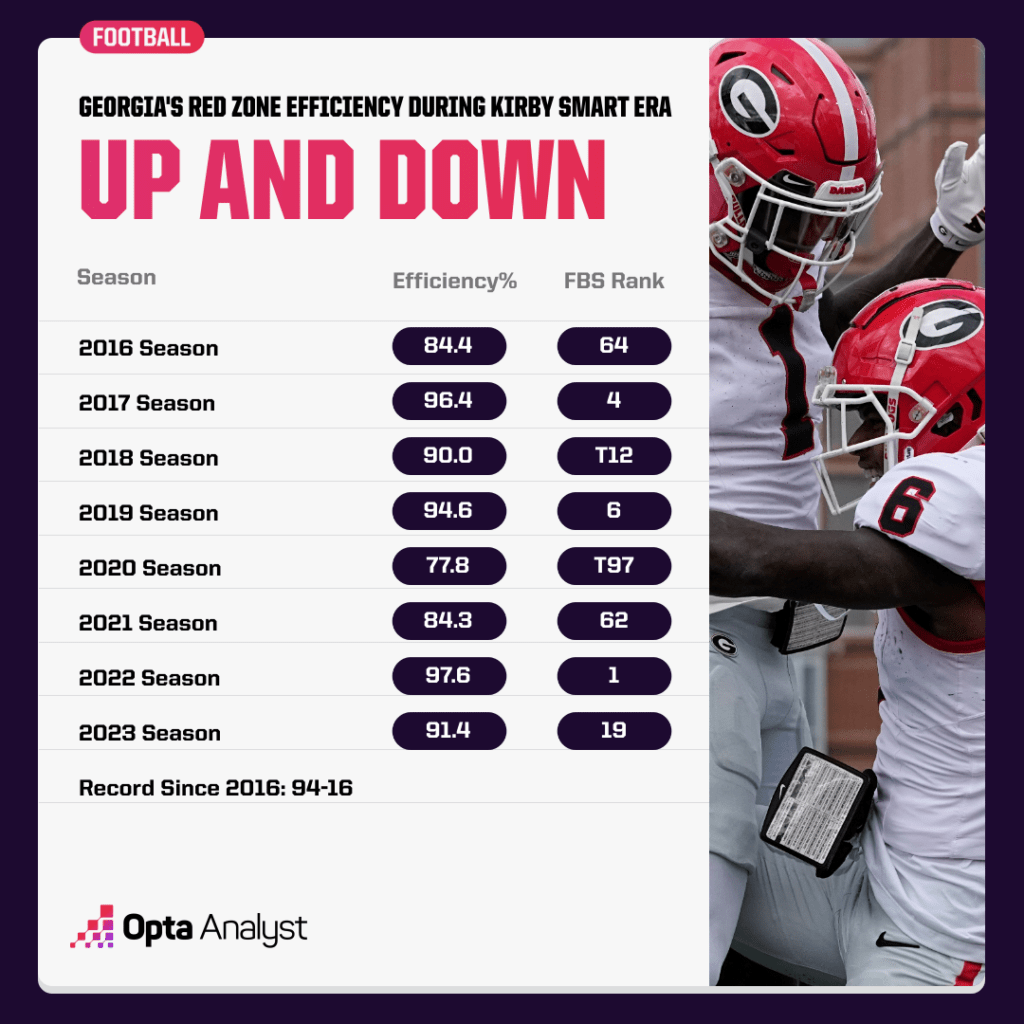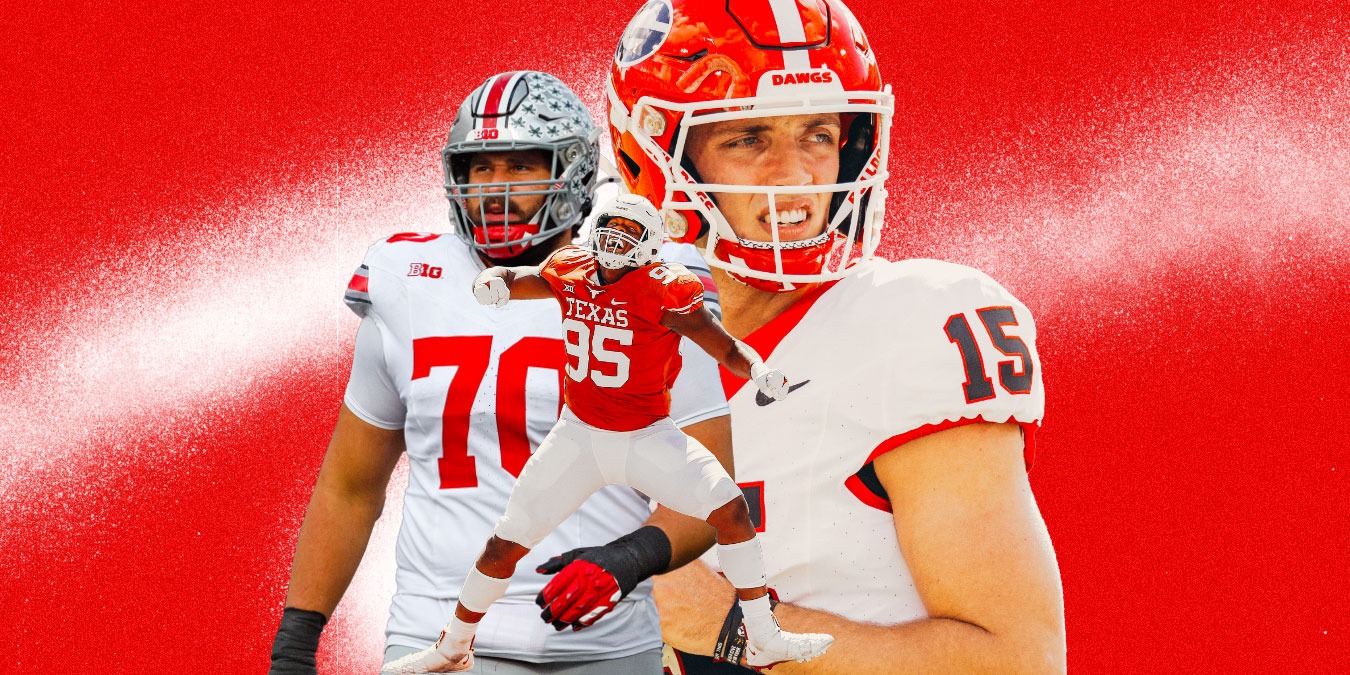With help from our game-tracking data, we’re examining a potential weaknesses with leading national title contenders heading into the college football 2024 season.
In college football, June and July are for optimism.
With pads yet to begin cracking across NCAA campuses, every team is poised to exceed expectations – whatever they are.
And every team ranked in the top 10 is poised to make a national championship run, with more mind paid to what could go right than what could go wrong.
At this time of year, even pretenders feel like contenders, so, yes, everything is great for everybody.
It won’t stay that way. Every FBS team but one will have a fatal flaw in its quest to be the first national champion of the 12-team College Football Playoff era.
College Football Playoff Schedule
(All Times ET)
First Round
- Friday, Dec. 20: 8 p.m. (ABC/ESPN)
- Saturday, Dec. 21: noon (TNT); 4 p.m. (TNT); 8 p.m. (ABC/ESPN)
Quarterfinals
- Tuesday, Dec. 31: 7:30 p.m. (Fiesta Bowl, ESPN)
- Wednesday, Jan. 1: 1 p.m. (Peach Bowl, ESPN); 5 p.m. (Rose Bowl, ESPN); 8:45 p.m. (Sugar Bowl, ESPN)
Semifinals
- Thursday, Jan. 9: 7:30 p.m. (Orange Bowl, ESPN)
- Friday, Jan. 10: 7:30 p.m. (Cotton Bowl, ESPN)
CFP National Championship
- Monday, Jan. 20 (Atlanta): 7:30 p.m. (ESPN)
Your team probably won’t win it all, but the one you dislike the most probably won’t, either.
In that hopeful spirit, we can use game-tracking data to go under the hood and spot loose bolts and design flaws that will bring most teams crashing down.
Following are five teams that start the 2024 season squarely in the national championship race mix and perhaps could grab the top five rankings in the Associated Press’ preseason top 25 poll (released in August). Each has a potential weakness that could hold it back from glory.
Ohio State’s Offensive Line
The Buckeyes have everything aligned to have a huge campaign. That includes the rival Michigan Wolverines, who have won The Game three years in a row, but are due for a step back following their national championship season due to losing a handful of top players and head coach Jim Harbaugh to the NFL.
The 12-team CFP guarantees Ohio State a spot unless disaster strikes. And at almost every position group, the Buckeyes bring back stars or solid players who have proven themselves already.
The offensive line is the fly in the ointment. It was bad last season.
Despite a highly regarded group of tailbacks, OSU’s rushing success rate of 37.9% lagged the 40% average of Power 5 teams. The Buckeyes allowed a run disruption rate of 55.4%, the worst mark in the Power 5 and one spot behind Iowa’s dreaded offense. In pass protection, the Buckeyes were a tick better than average in allowing a 31.3% pressure rate.
The O-line unit’s big offseason addition in the transfer portal was Alabama center Seth McLaughlin, who will take the same role in Columbus. McLaughlin’s 4.5% bad snap rate was the highest of any regular center in FBS last season.
Rectifying that will be the first step toward Ohio State’s line performing better in 2024.
Georgia’s Red Zone Efficiency
Trying to find a flaw in coach Kirby Smart’s machine is difficult work.
The Bulldogs are sure to make the Playoff, and if they lose any time before the national title game, it will be because some tiny hole expanded into a big one at the wrong time.
The best way to prevent that is to recruit elite talent and develop players – Georgia does both. But here’s an area where the ’Dawgs were more “good” than “elite” in 2023: Finishing drives.
UGA’s touchdown efficiency after entering the red zone was 71.2%, ranking 22nd in the FBS. But the timing of the failures was a problem: The offense made five red-zone trips against Alabama in the SEC Championship Game and collected just three touchdowns and a field goal, coming away empty another time in a game Georgia wound up losing by a field goal – and it cost the Bulldogs a CFP bid. Moreover, the team’s best red-zone weapon was tight end Brock Bowers, and he plays in the NFL now.

What Georgia does in the red zone won’t matter against the vast majority of its schedule, but we’ve already seen how it can cost the Dawgs on the margins.
Oregon’s Short Passing Game
The 2023 Ducks made their hay with a rhythmic, rapid-fire pass game keyed by quarterback Bo Nix. He was a master of throwing short passes, leading the FBS with an 86.2% well-thrown rate and ranking second with a 0.87 pickable pass percentage. As we wrote when the Denver Broncos took Nix with the 12th pick in the NFL Draft, the QB did all of that in the most constrained structure imaginable:
“That excellence came in structure. Nix averaged 6.7 air yards, 159th out of 164 quarterbacks. He did not freelance beyond what the Ducks asked of him; his 80.5% ‘in-design’ rate (ID%) was well above the 77.0% national average. (ID% measures how many of a quarterback’s plays unfold within the envisioned play call – as opposed, for instance, to scrambles and throws flushed from the pocket.) Nix buried opponents with a barrage of short passes and put up a 45-touchdown, three-interception season.”
Dillon Gabriel is expected to succeed Nix as the Ducks’ starting quarterback, but while playing at Oklahoma, he was in a much different system last year. He averaged 9.8 air yards per attempt, had 53 designed run attempts to Nix’s 30, posted a much-lower well-thrown rate of 80%, and released the ball in 2.59 seconds compared to 2.43 for Nix. He also threw pickable passes nearly three times as often as Nix (as a percentage of his throws) and made fewer of his throws in structure: His “in-design” rate was 73.7%.
None of that’s a criticism, as Gabriel was quite good for the Sooners. But he might as well have played a different sport from Nix.
Will Oregon’s offense evolve to be more like Gabriel’s at Oklahoma or will Gabriel evolve to play a much different style of quarterback?
Texas’ Defensive Trenches
The Longhorns were blessed last season with one of the best defensive tackle duos in recent memory: T’Vondre Sweat was a consensus first-team all-American, and fellow game-wrecker Byron Murphy was the Big 12’s defensive lineman of the year.
But now coach Steve Sarkisian faces a dilemma – the need to replace that tandem just as the Horns move to the SEC, which has the meanest set of linemen of any league.
The Sweat-Murphy defensive front was dominant. Texas ranked sixth among Power 5 conference teams in rushing success rate allowed (31.3%), seventh in yards allowed before contact (2.2), and first in run disruption rate (60.8%). The Horns also generated a 39.3% pressure rate despite only blitzing one in every four snaps – a rate well below the 28.2% Power 5 average.
Texas appears to have reinforcements ready. Longtime reserve Alfred Collins is a former four-star recruit, and he was one of the most effective pass-rushing tackles in the country as a backup. He’ll now start, and the program has other DT options in two Arizona transfers, Tiaoalii Savea and Bill Norton.
How well those players convert from paper to the field will determine how much ground Texas loses in the trenches. A step back from Sweat and Murphy is inevitable. A big one, though, would be problematic.
Notre Dame’s Offensive Tackles
The Fighting Irish had seven players selected in the NFL Draft off last year’s team, and the first two played on either end of the offensive line. Left tackle Joe Alt and right tackle Blake Fisher were the No. 5 and 59 overall picks, respectively.
In their absence, Marcus Freeman and new offensive coordinator Mike Denbrock will either need to develop good new tackles or build an offense around more-limited bookends.
Alt was an absolute stud. In 243 pass protection snaps, he allowed three pressures, two knockdowns and one hurry. He also allowed just a 5.3% run disruption rate, the lowest on the team. On 322 run-blocking snaps, Alt’s man blew up the play just 17 times.
Fisher wasn’t as good as Alt, but he still provided stability in the form of an 8.5% pressure rate allowed (to Alt’s 1.2%) and a 6.5% run disruption rate.
Notre Dame heads into the summer with sophomore Charles Jagusah slated to play on the left side and fifth-year senior Tosh Baker on the right. Jagusah played 61 snaps as a freshman, and he only pass-blocked on 14 snaps – such a small sample that it’s hard to draw many conclusions. Baker played a bit more and allowed a 16.7% pressure rate and 13.4% run disruption rate.
In larger samples this year, the Irish need both tackles to step up in a big way for new (and mobile) quarterback Riley Leonard. Another former backup, Aamil Wagner, is in the mix should Jagusah or Baker not get the job done.
Don’t Forget …
Even if you feel another program will be a college football playoff contender – Alabama, Florida State, Penn State, defending national champ Michigan, whoever – it’s likely that team has a weakness to worry about as well.
But it’s June, so have fun and dream the big dream.
Check out all our MLB, NBA and NFL coverage. And follow us on X and Instagram for more!
